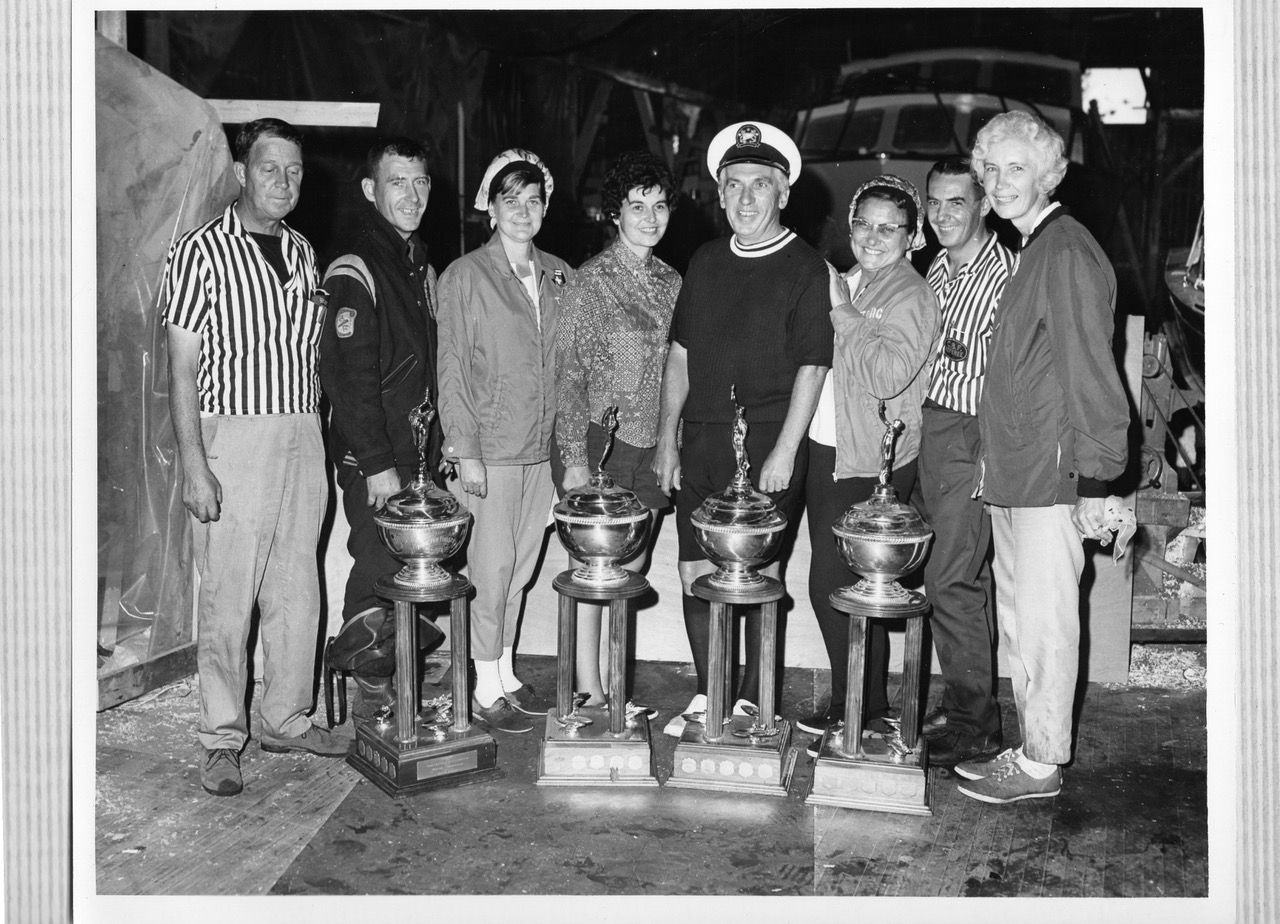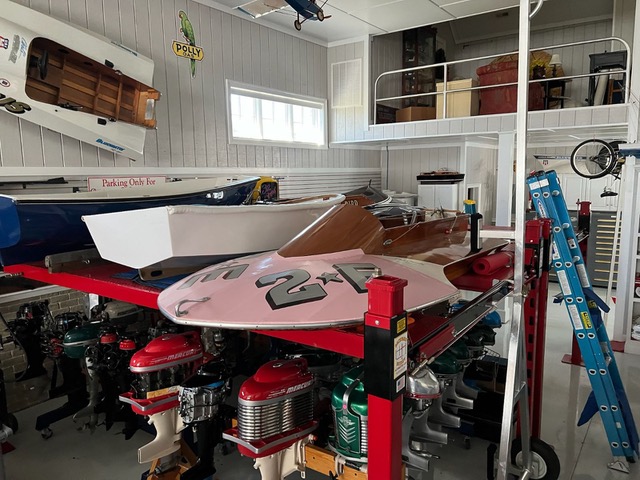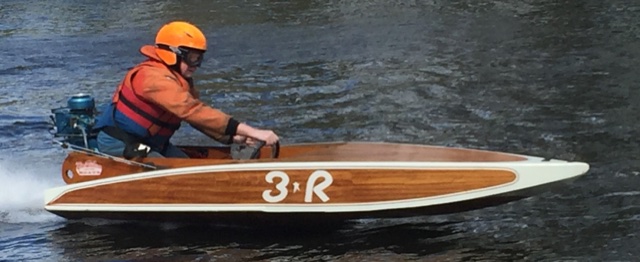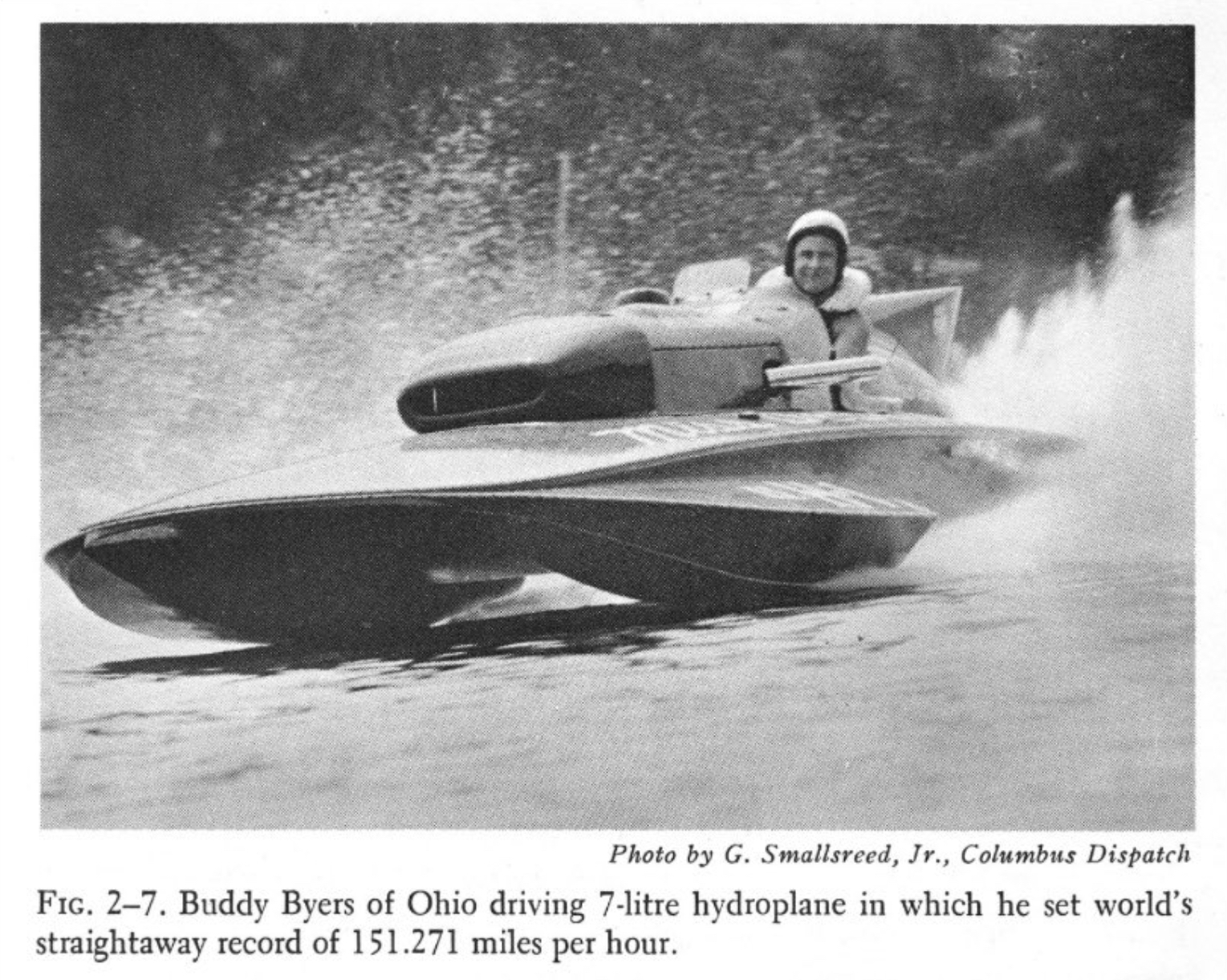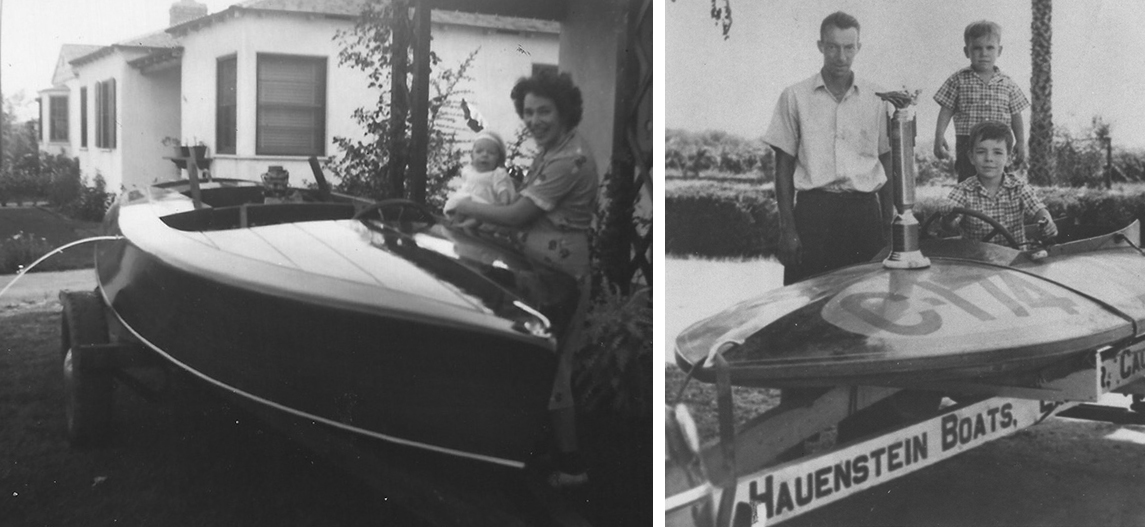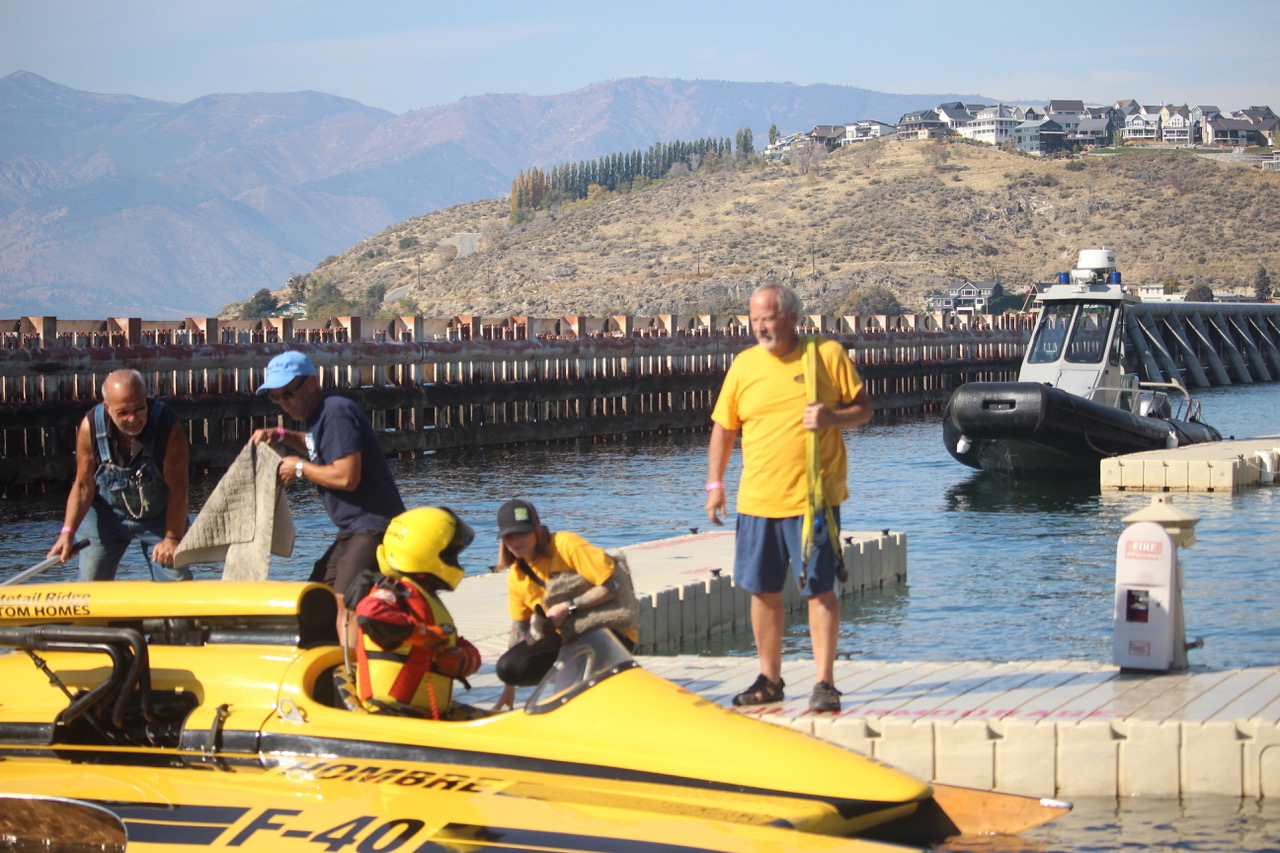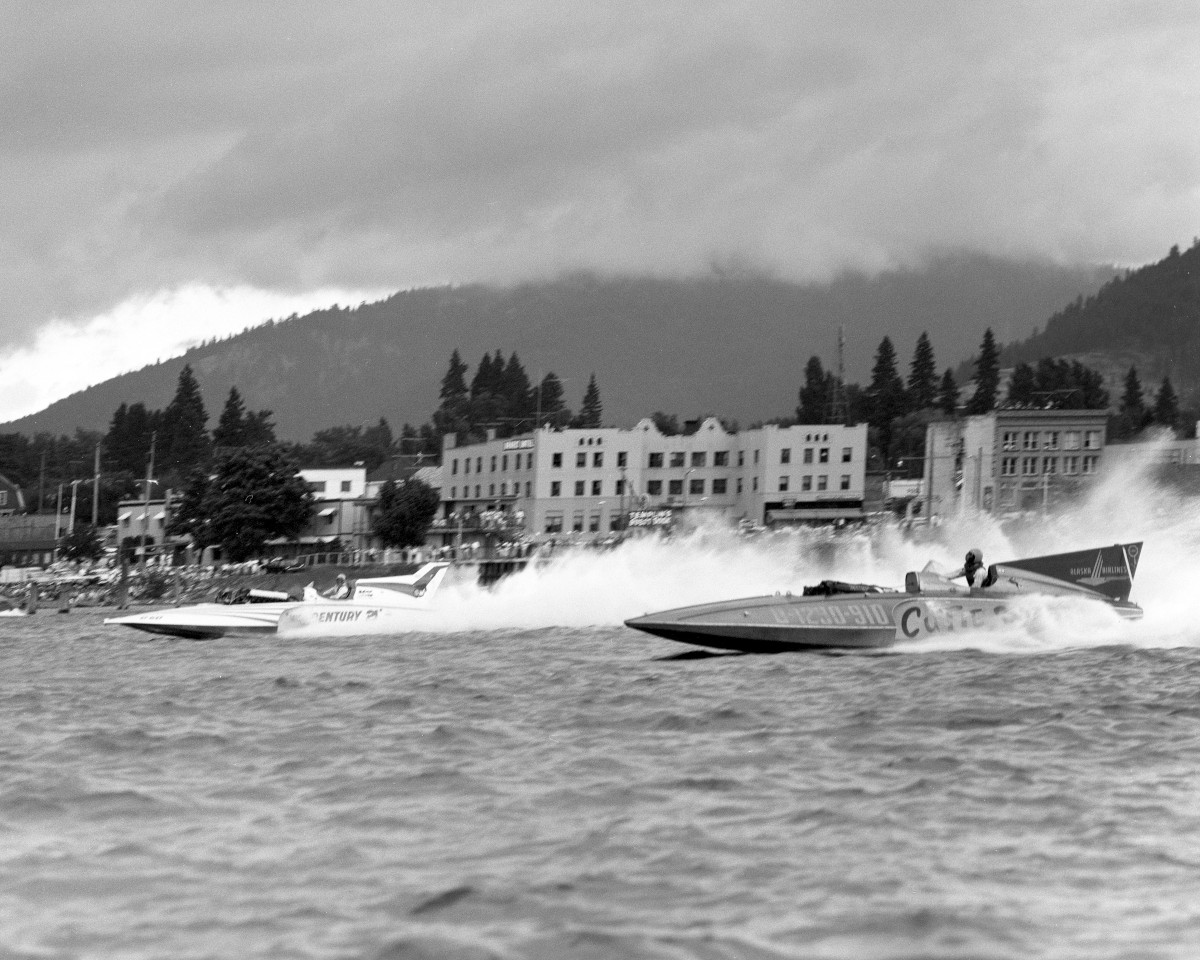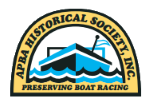Squirt Was a Mighty Force in Inboard Racing
December 25, 2023 - 8:07pm
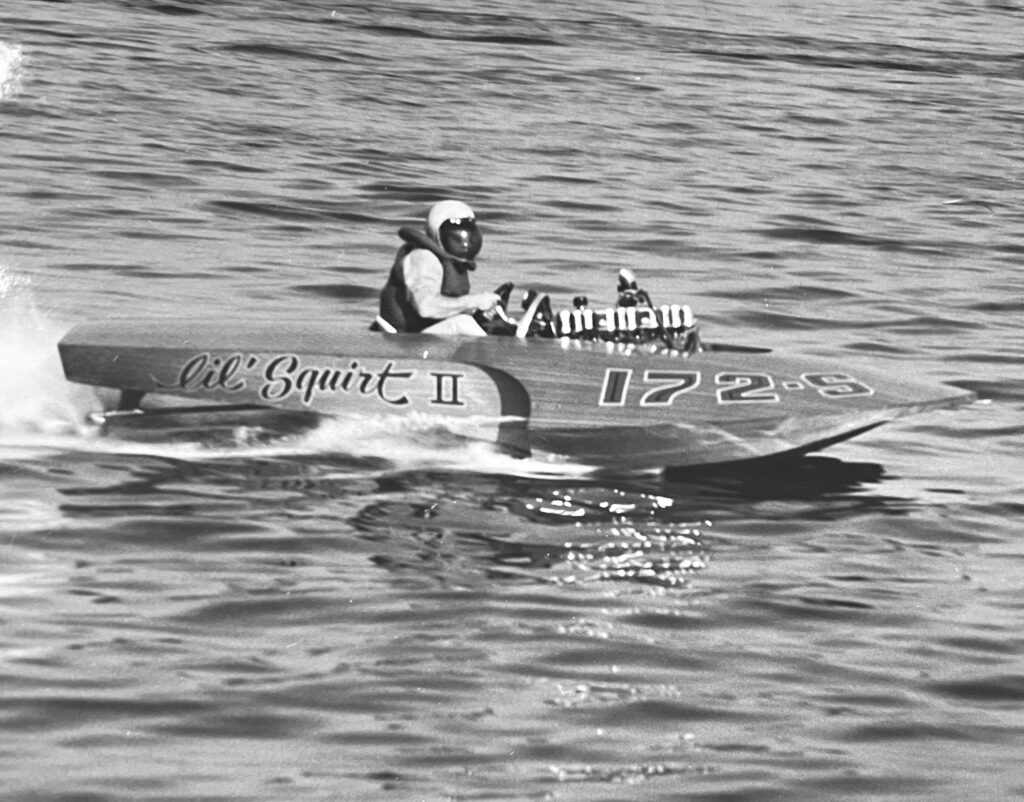
The 172-S Li’l Squirt II was a Sooy hull.
Bob Carver photo sent by Bruce McDonald
By Craig Fjarlie
Bruce McDonald was born in Tampa, Texas, 86 years ago. His family moved to Seattle in 1945 and a few years later, he was swept up in the city’s hydromania. He graduated from Roosevelt High School and the University of Washington, where he studied industrial engineering, with the intention of becoming a shop teacher.
“Then life started happening,” he remembers. “While I was still in college, I got married and my first son came along. While I was in high school and college I was working as a delivery boy for a downtown Seattle office equipment company. I was basically a typewriter repairman in those days, and worked in the Boeing Company in their office machine repair shop.”
In 1961 McDonald’s Navy Reserve unit was called up because of the Berlin crisis. McDonald knew the owner of a small office equipment company in the north end of Seattle. “He said, ‘If you’re ever on liberty, I could use some technical help.’ I actually worked part-time in this little office equipment company while I was in the Navy, when I was able to do it.”
When McDonald was out of the Navy, he went to work for the company as a technician. Soon, the owner had a serious illness and McDonald bought the company from him. “Over the next 30 years, I built it and had 100 employees when I sold the company to Icon Office Solutions. I spent the next 25 years teaching management classes for the real estate industry. Of course, during that whole period of time, my hydroplane racing probably took front and center over most things.”
During the 1950s, Unlimited hydroplanes were a big deal in Seattle, especially the competition with Detroit for the APBA Gold Cup. “I was extremely interested in them,” McDonald emphasizes. “My parents bought a place on the north end of Lake Washington. In those days, Stan Sayres would drive Slo-mo IV north up to Kenmore and cruise down the center of the lake. It was terribly exciting.”
Wally Pannebaker lived four doors south of the McDonald home. “In 1956 Wally decided he was going to get into hydroplane racing. He went to Ron Jones, who was quite young at the time, and he built what came to be a 7 Litre. At the time, the Unlimiteds had to be 25 feet long. Wally put a five-foot extension on the tail, which they ultimately outlawed,” McDonald explains. “It was a privilege that I crewed on that boat during the building stages and through the 1957 Gold Cup. We tried to qualify the boat under the name Whiz-ski. They let the boats stay around a few days following the event. Wally decided he was going to take me and a couple other people for a ride in Whiz-ski. Took the seat out, put a board in, and that was my first hydro ride, 1957. It was one of the most exciting experiences I’d ever had in my life. Wally’s son-in-law, Bill Jensen, and I were very close friends. We immediately started building our limited hydroplanes. I went to Chuck Hickling and bought a set of 136 plans, and Billy Jensen went to Norm Christiansen and bought a set of plans. Billy got his done more quickly, in time for the ‘58 Nationals on Lake Washington. I didn’t participate in the race, but I got to drive his 280. The following year I got my 136 done, so in 1959 I started my personal career.”
McDonald built his first boat with help from Frank Schneider. “We had a little Ford V-8 60 engine in it and ran it with some degree of success.”

“The S-71 Li’l Squirt was my first hydro, a Hickling 145 hull I built myself.” Photo courtesy of Bruce McDonald
McDonald is a rather short man and was sometimes called by the nickname Squirt. He named his first boat Lil’ Squirt. The 136 class became the 145 class, and McDonald re-powered the boat with a Ford Falcon engine. “I immediately began building Lil’ Squirt II, and Frank Schneider helped me with that whole program. It was a Sooy hull. A fellow by the name of Joe McMahon bought these Sooy-designed boats and modified them. This boat was designed to set a record and do all kinds of things. Ultimately it was a very fast boat, and with it I was able to be number two in the nation in High Points. We traveled all over. I won something like 27 consecutive heats with that boat. In fact, on Green Lake in 1963, I set a competition World Record with that boat, but we had a controversy. We were running a camshaft that was developed by Holman and Moody. You might actually call it more of a racing camshaft, although per the part number, it was 100 per cent legal. A guy back East had set a kilo record at the same time. The technical committee decided that though his record and my record were done legally, that wasn’t in the true interest of the class. They decided to call his straightaway record and my competition record a ‘historic performance.’ So we never made the record book.
McDonald did most of his own engine work. “I’ve always believed that if you have a rule, you’ve got to follow it to the nth degree,” he states. “Certainly, push ‘em as far as you can legally push ‘em. This boat (Lil’ Squirt II) was unbeatable. As a result, we got torn down all the time. They’d tear us down, not find anything, the next week I’d win again, they’d tear me down again and not find anything. C’mon, guys. So, they sent the engine home in a basket week in and week out. Fortunately, in those days, gaskets were cheap, but you’d end up spending all week reassembling your engine. Of course, I had machine shops do my machine work. But I did all my own tuning and all that engine work.”
Propellers were another matter. “In those days, there were really only two places where you could get them— from Hi J or Carey. If I had known then what I have learned since, we could have run a lot faster. That little boat ran a 10-½ x 17 inch two-blade propeller. We didn’t know much about props in those days. The outboarders knew a lot more about it than the inboarders, but they were almost like two different groups—very little interaction.”
At the close of the 1963 season, McDonald sold Lil’ Squirt II and stepped up to the 280 class. He drove a used Lauterbach hull owned by Larry Barry, a local racer who had been thrown from the boat and felt it was a handful to drive. “On Lake Sammamish in September of 1963, he said, ‘You drive it, I can’t do this.’ I won the first heat I was in handily. Ron Jones was the referee and all of a sudden he calls me to the official barge. I thought, ‘Oh, what did I do?’ He said, ‘We just wanted to tell you that you were one-tenth of a second off the World Record. Maybe you can make some adjustments and set a record in the second heat.’ Well, I won, but I didn’t get the start I wanted. Went ahead and ran it the rest of that year; and then in the winter between ‘63 and ‘64, I ended up buying the boat. Then it became Lil’ Squirt, E-92.”
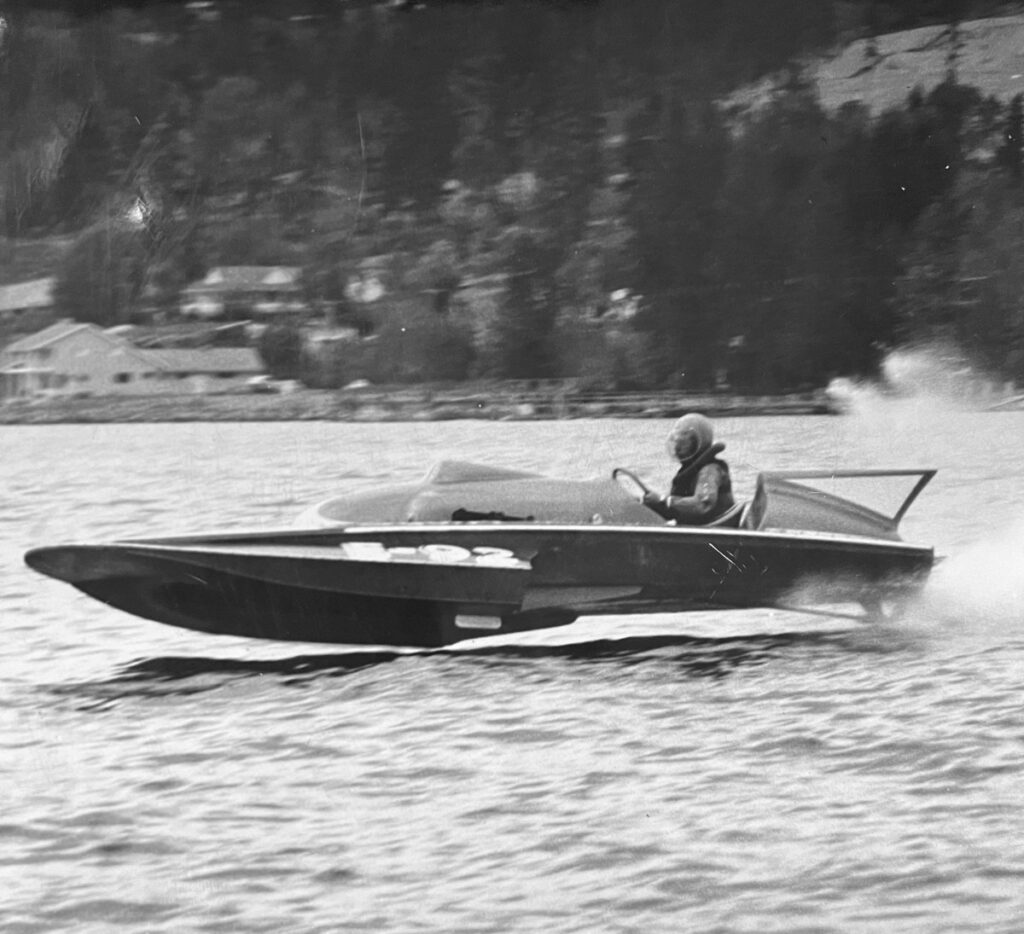
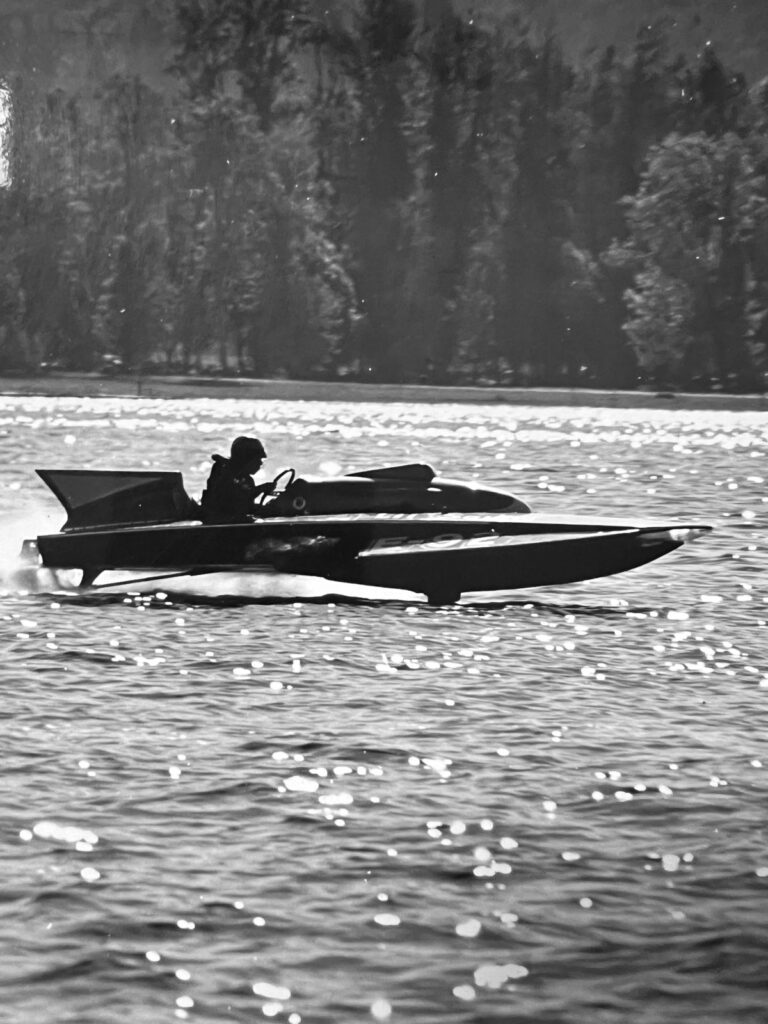
Lil’ Squirt E-92 was Bruce McDonald’s 280, a fast Lauterbach hull that required careful handling. Bob Carver photos sent by Bruce McDonald
Lauterbach hulls required a different driving style than most other hydroplanes of that era. “I always told people that driving a Lauterbach, you had to be really gentle, because they flew,” McDonald explains. “You couldn’t horse the boat; you had to finesse the boat. Going into the turn, you’d have to let the right sponson settle onto the chine and then away you’d go. If you tried to jam it, that right sponson would catch, then it would go upside down. Donnie Benson wanted to drive it one time down at Portland. He rolled it over, his very first race. Didn’t hurt the boat, but hurt his feelings,” McDonald laughs.
In 1964, the boat set a competition record on Lake Alouette in Canada. “That record held for 5-½ years. It was 64.807 miles per hour,” McDonald boasts. “Then in 1966, I caught a chine down at Mossyrock Dam. I tried to win the race in the first lap. I was the fastest boat by far, but I got a bad start.
“Somebody got ahead of me and I crossed his roostertail just going into the turn. Caught, and over it went. Had a cast on my left leg because I tore up my knee when I went out of the boat. I had Donnie Benson drive for me because I couldn’t get in the boat with a cast on. He ended up winning the National Championship here on Lake Washington in 1966 driving my boat.”
McDonald explains why he selected Donnie Benson to take over the cockpit duties. “He lived just south of me on Lake Washington. Of course, I’d known Donnie for a long time and used to hang out with his dad (Al Benson). He owned a Mercury Outboard dealership. Donnie was my size. He was one of the few people who could fit in my boat, plus I thought he was one of the few people capable of winning with the boat. I’ve always been aces high on Donnie. He was a very, very fine driver. When I got hurt in it, I still wanted it to run in the Nationals, so I asked Donnie if he would drive it. Of course, he jumped at the chance. Donnie drove the boat until its demise down at Dexter Dam. Frank Schneider blew over in his Karelsen. His rudder was sticking up and Donnie had the choice of running over Frank or going right over the boat. The darn rudder cut the Lauterbach in half.”
McDonald eventually sold the boat to Red Mansfield, of Tacoma. “I went looking for the boat when Vintages came in. I found out Red Mansfield had burned it. That’s kind of what we did in those days.”
Ed Karelsen approached McDonald about building a new 280 for him. “By then my World Record had been broken and he said, ‘How would you like to get your World Record back?’ I said, ‘Well, that’s pretty optimistic but the answer would be absolutely, if I could.’ So I had Ed build what we called The Bent Bullet, and that was the Ed Karelsen Special. I think it was in 1970 on Green Lake we set a new competition world record with the boat. That record hardly stood long enough to be in the books when one of George Babcock’s 280s, driven by Pat Berryman, broke the record. Then it volleyed back and forth between Al Curtis and John Leach, and several people broke the record.” McDonald sent the boat to Florida. “We raced at St. Petersburg in the Southland Sweepstakes and we won that race.”
At about the same time, McDonald became good friends with Jerry Bangs. “I actually got him started racing limiteds. He started in 145.” Soon, both were racing in the 5 Litre class. McDonald drove a Ron Jones hull, F-51, owned by Glen Davis. “I don’t know that Glen ever had a name for that boat. I was racing against Jerry Bangs and some of the other people, and he was almost unbeatable in the 5 Litre class. I even jumped the gun and couldn’t beat him.”
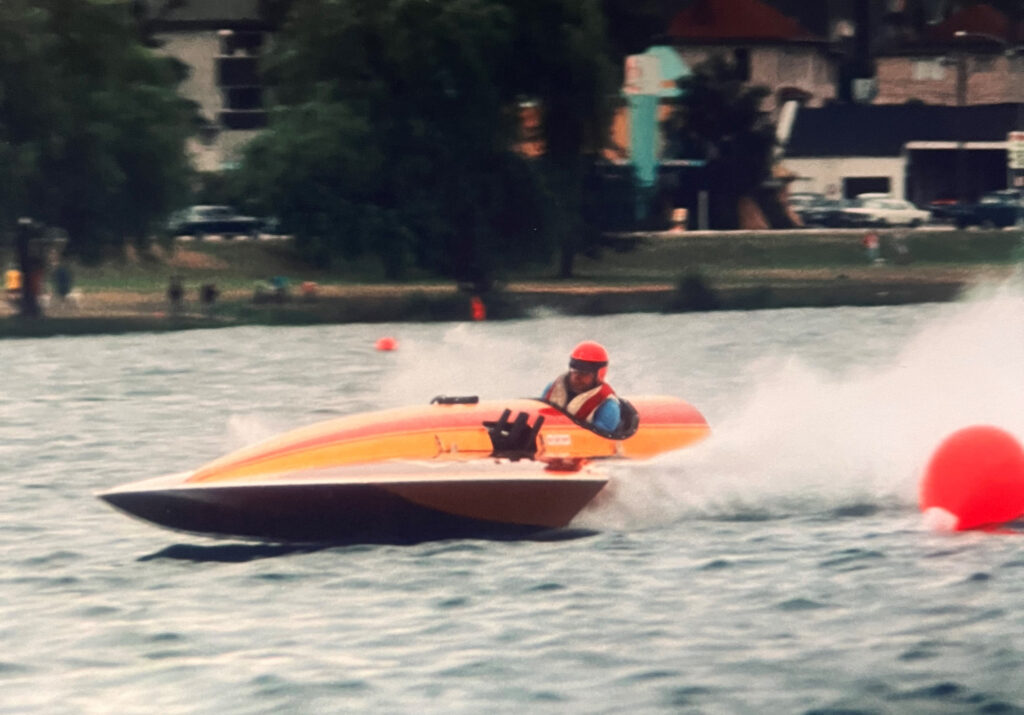
When Bangs began driving a 5 Litre, McDonald bought his 150 hydro. The boat had been built by Joe McMahon. “I ran that one season. I never changed the name. Jerry, being an attorney, named it The Verdict. I decided that Jerry was the bravest man in this class. That son of a gun, you’d be going down the straightaway at about 110, 115 miles an hour and it’d jump 10 feet sideways. I had a very strong full race Falcon engine in it. After that season I took it out to my back yard, took all of the hardware out, set it on fire, and burned it.”
McDonald had offers to drive Unlimited hydroplanes. “In the early days, most of the Unlimited drivers were some kind of airplane pilot. Bob Gilliam came to me and wanted me to drive one of his Fascinations. He had so many different names—KOLroy and all kinds of things. I talked to Bill Muncey about it. Muncey and I had been in the same fraternity in college—Lambda Chi—although he was at Rollins College in Florida. I actually met Bill when I was in college, when he first came out here with Thriftway. He and I were not bosom buddies by any means, but we formed a close friendship, and I really respected him. So, when I got the offer I went to Bill and I said, ‘What do you think?’ It’s kind of disrespectful, but he said, ‘Bruce, you’re too good. If you get a reputation for driving a pig boat’ —those were his words—‘you’ll never get a good boat.’ So I turned that down. Bill said, ‘Just go on and keep winning in limiteds. If you want it you’ll get your chance.’”
McDonald had another opportunity a few years later. “I kind of got a backend offer from George McKernan. He was crew chief of Miss Budweiser at the time. George asked me if I would like to drive the Budweiser. Well, who wouldn’t? So we entertained some conversation about at least testing the boat before the 1966 season. McKernan used to hang around down at Joe McMahon’s boat shop. Everybody knew him because he always went to limited races. Well, May 1 of 1966 I fell out of the boat and broke my left leg. That took care of that. Then fast forward to 1977. Jerry Bangs was my closest and dearest friend. Even though he was brand new to The Squire Shop, his dream was to have a two-boat team the next year. He always called me ‘Squirt’ and he said, ‘Would you consider coming out of retirement and racing with me?’ It was just conversation. I’m not sure if Bob Steil (owner of The Squire Shop racing team) was even aware of the conversation. I said, ‘Well, it certainly would be fun to do.’ The rest became history. Jerry ended up dying at Seafair that year and I just lost all interest. I’ve always said that my Unlimited career was put on hold by fate, or divine intervention, or whatever else, because it seemed like something came along and saved me from that. When you think about it, most of the good guys from that era are dead.”
One of the Unlimited champions from that period who survived is Chip Hanauer. “I was racing limiteds when Chip started driving for a guy named Ernie Lauber in a little 145,” McDonald recalls. “Of course, he had been racing outboards for ever and ever. I might not have been as lucky as Chip. I don’t know if he was lucky, but he’s still with us and I’m thankful for that.”
While he was busy racing, McDonald was a local leader in service to APBA. “I was Commodore of Seattle Inboard Association in ‘63 and ‘64. I was General Chairman for the ‘66 Nationals. Then I went on to become Region 10 Chairman in ‘68-’69. So, in addition to boat racing, I tried to give back.” He admits it was a busy time in his life. “I was trying to run a big company and raise three boys.” When he retired from the cockpit, he briefly worked as an official, but found it wasn’t his calling. “I’ve just never been a very good spectator,” he says with a slight laugh.
McDonald has an interest in vintage boats, but has yet to drive one. “When the Vintage Division came along, I thought, ‘Well, this would be great, I think I’ll get back into vintage.’ The first thing I did was try to find one of my old boats. I even ran ads. Of course, the Lauterbach got burned, but the two little 136s, I have not a clue. The last time the first Lil’ Squirt was seen it was in Bob Gilliam’s shop, hanging from the ceiling. I don’t know where it went. I called Larry Lauterbach and asked how much he would charge to build a replica of Lil’ Squirt and he gave me a very affordable price. I almost did it, but decided not to.”
McDonald is keeping the door open to eventually taking a turn driving a vintage boat. “Everybody keeps saying, ‘C’mon, you can drive, we’ll let you do it.’ My current wife wasn’t with me through all of this, but she was aware of the danger. She almost has a fit when I tell her I’m going to run one of those vintage boats. But I still suspect I will. I’m still full of energy and life, though I’m 86 years old. I’m blessed with good health and good vitality, all my good old faculties.”
Looking back at his years in racing, McDonald has fond memories. “My limited career is something that’s very, very special to me. I’m very proud of my accomplishments. By the same token, I’ve always said that’s all history. It’s what you do today that counts, though it’s fun to reminisce.” Bruce McDonald, the Squirt, has left his mark on APBA history, and for that we are thankful.
Featured Articles

